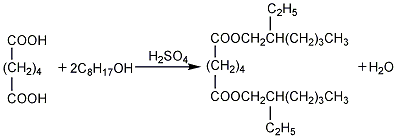Dioctyl adipate Bis(2-ethylhexyl)adipate


Structural formula
| Business number | 02N3 |
|---|---|
| Molecular formula | C22H42O4 |
| Molecular weight | 370.58 |
| label |
Di(2-ethylhexyl) adipate, Diisooctyl adipate, Plasticizer DOA, Diisooctyl adipate, Plasticizer DOA, DOA adipate, Adipic acid di(2-ethylhexyl) ester, DOA, Cold-resistant plasticizer, rubber softener, Synthetic lubricants |
Numbering system
CAS number:103-23-1
MDL number:MFCD00009496
EINECS number:203-090-1
RTECS number:AU9700000
BRN number:1803774
PubChem number:24874479
Physical property data
1. Properties: colorless or slightly yellow oily liquid with special odor.
2. Relative density (g/mL, 20/20℃): 0.9268
3. Melting point (ºC): -67.8
4. Boiling point ( ºC): 2145
5. Boiling point (ºC, 0.53kPa): 208~218
6. Refractive index (25ºC): 1.4466
7. Flash point (ºC, closed): 194
8. Autoignition point or ignition temperature (ºC): 235
9. Vapor pressure (kPa, 200ºC): 0.32
10. Vapor pressure (kPa, 85ºC): 0.00013
11. Viscosity (mPa·s, 20ºC): 13.7
12. Heat of evaporation (KJ/mol): 95.0
13. Solubility: Soluble in methanol, toluene, chlorine solvent, ethyl acetate, mineral oil, vegetable oil and other organic solvents. Insoluble in water, slightly soluble in ethylene glycol.
14. Relative density (25℃, 4℃): 0.922
15. Refractive index at room temperature (n20): 1.4474
Toxicological data
1. Irritation: rabbit eyes: open irritation test, 500mg, causes irritation. Rabbit eye: 500mg/24 hours, mild irritation.
2. Acute toxicity: rat oral LD50: 9100mg/kg; rabbit dermal LD50: 16.3mL/kg.
3. The lethal dose to the human body is approximately 500,000mg/kg body weight. The oral median lethal dose (LD50) for rats is 3000~6000mg/kg.
4. It is slightly toxic. Rats inhaled saturated vapor for 8 hours without death.
Ecological data
This substance is harmful to the environment, and special attention should be paid to the pollution of water bodies.
Molecular structure data
1. Molar refractive index: 107.43
2. Molar volume (cm3/mol): 399.4
3. Isotonic specific volume (90.2K): 951.6
4. Surface tension (dyne/cm): 32.2
5. Dielectric constant:
6. Dipole moment (10-24cm 3):
7. Polarizability: 42.59
Compute chemical data
1. Reference value for hydrophobic parameter calculation (XlogP): 6.8
2. Number of hydrogen bond donors: 0
3. Number of hydrogen bond acceptors: 4
4. Number of rotatable chemical bonds: 19
5. Number of tautomers: none
6. Topological molecule polar surface area 52.6
7. Number of heavy atoms: 26
8. Surface charge: 0
9. Complexity: 320
10. Number of isotope atoms: 0
11. Determine the number of atomic stereocenters: 0
12. Uncertain number of atomic stereocenters: 2
13. Determine the number of chemical bond stereocenters: 0
14. Number of uncertain chemical bond stereocenters: 0
15. Number of covalent bond units: 1
Properties and stability
Avoid contact with strong oxidizing agents. It is a relatively stable compound.
Storage method
Store in a cool, ventilated warehouse. Keep away from fire and heat sources. Protect from direct sunlight. Keep container tightly sealed. should be kept away from oxidizer, do not store together. Equipped with the appropriate variety and quantity of fire equipment. The storage area should be equipped with emergency release equipment and suitable containment materials.
Synthesis method
Put adipic acid and octanol into the reaction kettle at a molar ratio of 1:2.5, add 0.1% sulfuric acid by mass of adipic acid, raise the temperature with stirring, and evacuate. Control the esterification temperature to 120~130℃, the vacuum degree to 86.7~90.7kPa, and the reaction time to 2h. Activated carbon is added to the reaction, with a mass of about 5% of the mass of adipic acid, to adsorb oxygen and decolorize. After the reaction is completed, the esterification liquid is neutralized with 2% liquid alkali at a temperature of 60 to 65°C. Let sit to layer. The ester layer is then washed with warm water at 60 to 65°C. The crude ester after removing the water layer is distilled under reduced pressure, dealcoholized under vacuum conditions of 933kPa and 150-160°C, and octanol is recovered. The dealcoholized ester is filtered to obtain the finished product. If further refinement is required, high vacuum distillation can be performed to collect the fraction at 210°C and 667Pa.
Refining method: Contains impurities such as free acid and alcohol. During refining, dry with anhydrous potassium carbonate and then distill under reduced pressure.

Purpose
This product is a typical cold-resistant plasticizer for polyvinyl chloride, vinyl chloride copolymer, polystyrene, nitrocellulose and synthetic rubber. It has high plasticizing efficiency and little thermal discoloration. It can give products good low-temperature flexibility and light resistance. . Used together with dioctyl phthalate, etc., it can be used in cold-resistant agricultural films, frozen food packaging films, artificial leather sheets, and outdoor water pipes. This product is non-toxic and can be used as food packaging materials. This product is highly volatile and has certain deficiencies in water resistance, migration, and electrical insulation. In addition, it is also used in rubber softeners and synthetic lubricants. This product is often used together with dioctyl phthalate.
